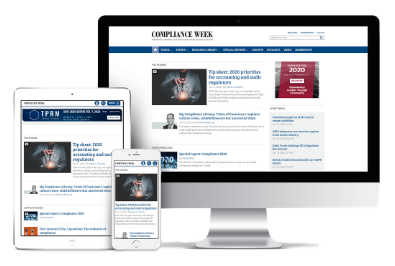In May, the International Compliance Association hosted a webinar looking at the importance of creating impactful compliance training.
The International Compliance Association (ICA) is a professional membership and awarding body. ICA is the leading global provider of professional, certificated qualifications in anti-money laundering; governance, risk, and compliance; and financial crime prevention. ICA members are recognized globally for their commitment to best compliance practice and an enhanced professional reputation. To find out more, visit the ICA website.
The webinar focused on providing practical tips for engaging learners beyond the traditional tick-box approach. Host David Povey, associate course director at International Compliance Training, was joined by Paul Eccleson, risk and compliance consultant at Gail Bragg; Steve Brett, co-founder of E3 Compliance Training Limited; and Jochen Vankerckhoven, founder of Compliance Explained.
Povey started by outlining how compliance training has “become more important than ever in today’s rapidly evolving business landscape” and how high-quality training is vital in protecting an institution from breaching rules or regulations leading to monetary sanctions. But perhaps more importantly, training can empower employees to carry out their roles to the best of their abilities and ultimately help to protect customers.
However, traditional approaches to compliance training can have minimal impact, as they often leave learners uninterested, disengaged, and fatigued. Such is where intervention is required to ensure the training becomes impactful.
Why learners disengage
The webinar polled attendees on reasons for learner disengagement in compliance training. Options given included:
- Lacking interactive and engaging content, which received 29 percent of votes;
- Lengthy and dense training materials (35 percent);
- Limited relevance to job roles and responsibilities (27 percent); and
- Insufficient interactivity and learner participation (9 percent).
Eccleson considered how the current approach to compliance training in so many organizations isn’t written with the intention to change behaviors but simply to protect the company, thus it is driven entirely around meeting regulatory requirements.
Measures of “successful” compliance training might be constructed around the number of employees who complete the training, when it should be measured through behavioral changes such as the number or quality of suspicious activity reports, reduction in compliance breaches, or an increase in questions to and engagement with the compliance department.
Vankerckhoven added the format and appearance of training is another reason for learner disengagement. Typically, training modules are simply PowerPoint presentations that have been added to an online system listing all the regulatory risks for learners to remember without allowing for learner engagement, interaction, or feedback. He likened it to attending a yoga class and receiving a lecture from the yoga teacher without actually doing any exercises.
Brett said, historically, the process most people use to produce compliance training was developed many years ago, when compliance was treated as just a box-ticking exercise. While the compliance industry has continued to grow and evolve since then, the training provided hasn’t kept up with the pace of change, as many companies see it being easier and cheaper to keep it the way it always has been.
Power of audience-driven training
In a second poll, 70 percent of the audience agreed audience-driven training was extremely important. Vankerckhoven said the aim of training should be to get everybody on the same page, and that the training should be made relevant to the audience’s tasks and responsibilities, ideally through scenario-based activities.
Brett highlighted how important it is to ensure learners want to take the training and they aren’t just completing it because the business tells them they must. The best way to create training that is interesting to learners is for those producing the training to put themselves in the shoes of the learners, gaining an understanding of what motivates them, what engages them, what challenges they face, and what has the greatest impact on them.
Eccleson introduced a behavioral framework known as EAST. When trying to engage people, learning should be:
- Easy: This doesn’t mean the training itself must be easy, but the materials need to be easily accessible and available.
- Attractive: Training material should be visibly appealing and interactive.
- Social: The training should be reflective of the day-to-day activities learners undertake.
- Timely: Training should be as frequent as required, not just a once-a-year exercise.
Metrics for success
Asked which data-driven metrics are valuable in assessing the effectiveness of compliance training, 77 percent of respondents said real-life application and behavior change was most important.
Brett highlighted completion rates were an important metric and should not be ignored, but if this is the only metric being used then people are not going to get to where they need to be regarding compliance training. Making sure people are being trained is an important first step, but to ascertain whether it is having an impact, linking to operational metrics is a must (e.g., looking at “near misses” regarding regulatory breaches, or root causes for breaches, and seeing whether these metrics improve over time).
Vankerckhoven added to establish effective metrics, it is important to take a step back and focus on internal investigations that have taken place in your organization, what happened, and what was done and then measure against that in the future to establish whether training is having an impact. Simply put, find something that went wrong, find the solution, conduct training around this scenario, and measure whether the initial issue has been improved upon.
Eccleson discussed dangers relating to metrics, one being “the attitude behavior gap” and another being the importance of setting the right metrics.
How can compliance officers promote engagement?
The webinar’s final poll revealed 35 percent of respondents believe delivering interactive and engaging training sessions to empower learners is the most important role of compliance officers, followed by 28 percent who believe it is creating a supportive and open learning environment. Twenty-one percent said regularly communicating with learners and addressing their concerns is of top importance, followed by 16 percent who said providing clear and relevant training objectives and expectations.
Eccleson outlined the difficult task compliance officers face in promoting learner engagement during training. The day-to-day roles of the compliance officer focus on regulation, regulatory risk, and writing and implementing policies, and compliance officers must try and influence their teams, often made up of many individuals, who do the day-to-day work and are the risk takers. He said the primary role of the compliance officer is influencing, negotiating, and communicating the right set of behaviors and not the wrong ones, with training being just one facet of this.
Brett expressed it is important compliance officers ensure all staff members are trained to the same level, as often the weakest link in an organization is not where you think it is. From there, extra or more specialized training can be delivered to specific teams if need be. Often, most areas of the business need to have an awareness of those risks as well. Keeping things simple and giving all staff members the same training can be a better solution.
Vankerckhoven added it is crucial for compliance officers to always link to the original learning objectives and build from there. He believes it is important to consider which staff members just need information, which require awareness, and which need to take actions. He said the role of the compliance officer is currently very difficult, with responsibilities including regulatory risk; educating; entertaining to drive engagement in training; and contributing to environmental, social, and governance measures.
The International Compliance Association is a sister company to Compliance Week. Both organizations are under the umbrella of Wilmington plc.











No comments yet